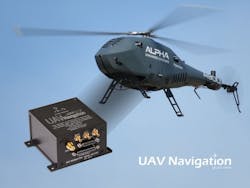UAV Navigation's GNSS-denied navigation capability keeps Alpha platform helicopter UAVs flying
MADRID - The majority of Uncrewed Aerial Systems (UAS) rely on Global Navigation Satellite Systems (GNSS) to maintain a stable position and/or to navigate between waypoints. Any small drone system that relies exclusively on Microelectromechanical Systems (MEMS) sensors to estimate aircraft attitude and which does not fuse data from other types of sensor may be vulnerable to GNSS jamming attacks. UAV Navigation in Madrid, Spain, says its design philosophy is that the UAV cannot depend upon the availability of a GNSS signal; the system must be able to continue the mission even in a GNSS-denied environment.
When a flight control system is jammed, or operates in a GNSS-denied area, the UAS no longer has access to positional information. With inferior systems, the only alternative is for the remote pilot to take manual control, making it likely that the mission will fail and depending on the distance between the Ground Control Station (GCS), the UAV may be lost. As mentioned above, some systems may not even be able to maintain UAV stability and the aircraft will fall out of the sky.
This is a major weakness of many commercially available drone systems, and it is what has made jammers and other counter-UAV measures so popular in the industry.
Alpha Unmanned Systems selected UAV Navigation as its flight control system provider due to their requirement to include a robust GNSS-denied capability in their UAV helicopters Alpha-800 and Alpha-900 systems.
With UAV Navigation's VECTOR-600 autopilot, Alpha's platforms are able to continue a mission if the GNSS signal becomes unavailable or is jammed; the autopilot is able to estimate the UAV's position and follow a flight plan, or alternatively receive a command to fly to a designated area - including the landing site, even if the UAV is Beyond Line Of Sight (BLOS). Of course the autopilot's sensor suite uses MEMS technology, so the system will accumulate navigation errors of up to 30 meters per minute; wind conditions may alter this figure, but the key point is that platform stability and control is maintained and the aircraft can be recovered.

